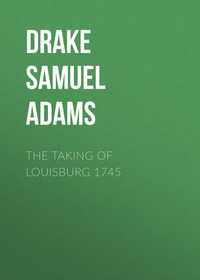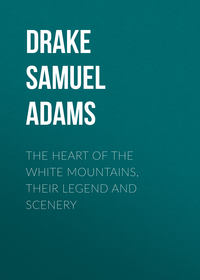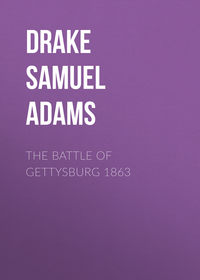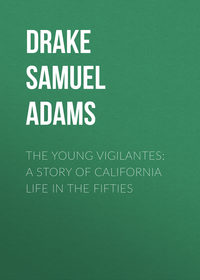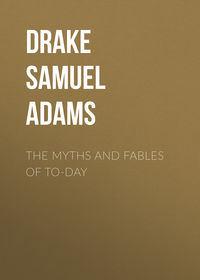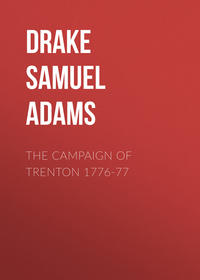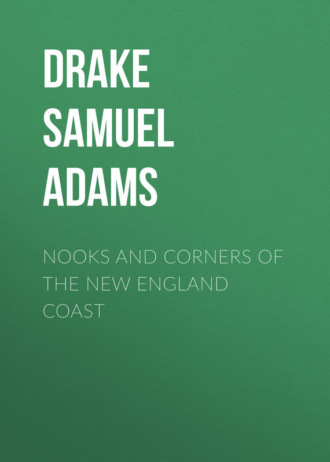 полная версия
полная версияNooks and Corners of the New England Coast
1724. After the Indians had cut off Captain Winslow and thirteen of his men in the River St. George, encouraged by this success, the enemy made a still greater attempt by water, and seized two shallops at the Isles of Shoals. – Hutchinson's "Massachusetts," vol. ii., p. 307.
107
Mountains seen off the coast: Agamenticus, twelve miles north of the entrance of the Piscataqua; three inferior summits, known as Frost's Hills, at a less distance on the north-west. In New Hampshire the first ridge is twenty or thirty miles from sea, in the towns of Barrington, Nottingham, and Rochester – the summits known as Teneriffe, Saddleback, Tuckaway, etc. Their general name is the Blue Hills. Beyond these are several detached summits – Mount Major, Moose Mountain, etc.; also a third range farther inland, with Chocorua, Ossipee, and Kearsarge. In the lofty ridge, separating the waters of the Merrimac and the Connecticut is Grand Monadnock, twenty-two miles east of the Connecticut River; thirty miles north of this is Sunapee, and forty-eight farther, Moosehillock. The ranges then trend away north-east, and are massed in the White Hills.
108
John Ward Dean, of Boston, the accomplished antiquary, has elicited this and other facts relative to his namesake.
109
On Boone Island it is said there is no soil except what has been carried there.
110
1670. The General Court being informed that there is a ship riding in the road at the Isle of Shoales suspected to be a pirat, and hath pirattically seized the sayd ship and goods from some of the French nation in amity with the English, and doeth not come under comand, this Court doeth declare and order that neither the sayd ship or goods or any of the company shall come into our jurisdiction, or be brought into any of our ports, upon penalty of being seized upon and secured to answer what shall be objected against them. – "Massachusetts Colonial Records," vol. iv., part ii., p. 449.
111
After execution the bodies of the pirates were taken to the little island in Boston harbor known as Nix's Mate, on which there is a monument. Fly was hung in chains, and the other two buried on the beach. The total disappearance of this island before the encroachments of the sea is the foundation of a legend. Bird Island, in the same harbor, on which pirates have been executed, has also disappeared. It formerly contained a considerable area.
112
A somewhat more authentic naval conflict occurred during the war of 1812 with Great Britain, when the American privateer, Governor Plummer, was captured on Jeffrey's Ledge by a British cruiser, the Sir John Sherbroke. The American had previously made many captures. Off Newfoundland she sustained a hard fight with a vessel of twelve guns, sent out to take her. She also beat off six barges sent on the same errand.
113
1686. Ordered that no shipps do unliver any part of their lading at the Isles of Shoals before they have first entered with the Collector of H. M. Customs, and also with the officer receiving his majs imposts and revenues arising upon wine, sperm, &c., imported either in Boston, Salem, or Piscataqua; and that all shipps and vessells trading to the eastward of Cape Porpus shall enter at some of the aforesaid Ports, or at the town of Falmouth in the Prov. of Maine. – "Massachusetts Council Records," vol. i., p. 43.
114
Boston, 1850: original in possession of Dorchester Antiquarian Society.
115
Mount Wollaston, Quincy, Massachusetts; present residence of John Quincy Adams, Esq.
116
See "Massachusetts Historical Collections," vol. iii., p. 63.
117
British State Papers, Calendars.
118
Spanish ship Sagunto, Carrera, seventy-three days from Cadiz for New York, arrived at Newport on Monday, January 11th, out of provisions and water, and the crew frost-bitten. Cargo, wine, raisins, and salt. Saw no English cruisers, and spoke only one vessel, a Baltimore privateer. —Columbian Centinel, January 16th, 1813.
119
Appledore, a small sea-port of England, County of Devon, parish of Northampton, on the Torridge, at its mouth in Barnstable Bay, two and a quarter miles north of Bideford. It is resorted to in summer as a bathing-place, and has a harbor subordinate to the port of Barnstable. – "Gazetteer."
120
Levett says, "Upon these islands are no salvages at all."
121
Mrs. Celia Laighton Thaxter.
122
The Act of Corporation, though well preserved, appeared little valued; it hung by a corner and in a light that was every day dimming the ink with which it had been engrossed.
123
The reader will do well to consult Belknap's admirable "History of New Hampshire," vol. ii.; Adams's "Annals," or Brewster's "Rambles about Portsmouth." Some sort of defense was begun here very early. In 1665 the commissioners of Charles II. attempted to fortify, but were met by a prohibition from Massachusetts. In 1700 there existed on Great Island a fort mounting thirty guns, pronounced by Earl Bellomont incapable of defending the river. Colonel Romer made the plan of a new work, and recommended a strong tower on the point of Fryer's (Gerrish's) Island, with batteries on Wood and Clark's islands. In December, 1774, John Langdon and John Sullivan committed open rebellion by leading a party to seize the powder here. The fort was then called William and Mary. Old Fort Constitution has the date of 1808 on the key-stone of the arch of the gate-way. Its walls were carried to a certain height with rough stone topped with brick. It was a parallelogram, and mounted barbette guns only. The present work is of granite, inclosing the old walls. The new earth-works on Jaffrey's Point and Gerrish's Island render it of little importance.
124
Governor of New Hampshire from 1682 to 1685. The house is the residence of Mr. Albee.
125
Odiorne's Point is in Rye, New Hampshire. The settlement began under the auspices of a company, in which Gorges and Mason were leading spirits. Their grant covered the territory between the Merrimac and Sagadahoc rivers. Under its authority, David Thompson and others settled at Little Harbor, and built what was subsequently known as Mason's Hall. Disliking his situation, Thompson removed the next spring to the island now bearing his name in Boston Bay. From this nucleus sprung the settlements at Great Island and Portsmouth. The settlement at Hilton's Point was nearly coincident.
126
Peace with the thirteen colonies was proposed under the administration of Rockingham, about the last official act of his life. His name is often met with in Portsmouth.
127
The house stands at the north end of Manning, formerly Wentworth Street, and is thought from its size to have been a public-house. The same house was also occupied by Lieutenant-Governor John, son of Samuel Wentworth. Samuel was the son of William, the first settler of the name. He had been an innkeeper, and had swung his sign of the "Dolphin" on Great Island. Hon. John Wentworth, of Chicago, is the biographer of his family.
128
His second wife was Henrietta du Roy, daughter of Frederick Charles du Roy, generalissimo to the King of Denmark.
129
Bennington, Vermont, is named from Governor Wentworth.
130
Her grandfather, Hon. Richard Hilton, of Newmarket, was grandson of Edward, the original settler of Dover, New Hampshire, and had been a justice of the Superior Court of the Province. – John Wentworth.
131
Frances Deering Wentworth married John just two weeks after the decease of her first husband, Theodore Atkinson, also her cousin, and in the same church from which he had been buried – matter for such condolence and reproof as Talleyrand's celebrated "Ah, madame," and "Oh, madame." Benning Wentworth's widow married Colonel Michael Wentworth, said to have been a retired British officer. He was a great horseman and a free liver. Once he rode from Boston to Portsmouth between sunrise and sunset. Having run through a handsome estate, he died under suspicion of suicide, leaving his own epitaph, "I have eaten my cake." Colonel Michael was the host, at the Hall, of Washington. In 1817, the house at Little Harbor was purchased by Charles Cushing, whose widow was a daughter of Jacob Sheaffe.
132
"Paul Jones shall equip his Bonne Homme Richard; weapons, military stores can be smuggled over (if the English do not seize them); wherein, once more Beaumarchais, dimly as the Giant Smuggler, becomes visible – filling his own lank pocket withal." – Carlyle, "French Revolution," vol. i., p. 43.
133
Mather and Hutchinson deal largely with it. Upham and Drake have compiled, arranged, and analyzed it.
134
Exod. xxii., 18 (1491 b. c.): "Thou shalt not suffer a witch to live."
135
Abigail Williams, eleven; Mary Walcut, seventeen; Ann Putnam, twelve; Mercy Lewis, seventeen; Mary Warren, twenty; Elizabeth Booth, eighteen; Sarah Churchill, twenty; Susannah Sheldon, age not known.
136
Account of Thomas Brattle.
137
See his life, page 80.
138
Endicott had a grant of three hundred acres on the tongue of land between Cow-house and Duck rivers. The site does justice to his discernment.
139
Raised in 1837 to the memory of soldiers of Danvers killed in the battle of Lexington.
140
The Queen's portrait by Tilt, the gold box and medal presented by the city of London and by Congress to Mr. Peabody.
141
Considerable changes were necessary so long ago as 1674-'75, when it became the property of Jonathan Corwin, of witchcraft notoriety. In 1745, and again about 1772, it underwent other repairs, leaving it as now seen.
142
A scene from life in the old Copp's Hill burial-ground at Boston.
143
She approved Governor Phips's conduct, but advised the utmost moderation and circumspection in all proceedings for witchcraft. – "Manuscript Files."
144
Samuel Sewall, afterward chief-justice of the Supreme Court of the province.
145
Some of the pins said to have been thrust by witches into the bodies of their victims are still preserved in Salem.
146
This incident appears in Hawthorne's "Seven Gables." The tradition is that Noyes was choked with blood – dying by a hemorrhage.
147
Captain Goelet calls it an island.
148
Treville was the man thought most worthy by Napoleon to lead his fleet in the long-meditated descent on England.
149
"Address to the Electors of Bristol."
150
"Philosophical Transactions," vol. lxiv., part ii.
151
A headland of Boston Harbor is named for him, Point Allerton.
152
"Moses Maverick testifieth that in the yeare 1640 or 41 the toune of Salem granted unto the inhabitants of Marblehead the land we now injoy, with one of Salem, to act with us, wh acordingly was acordingly attended unto the yeare 1648, in which yeare Marblehead was confirmed a toune, and to that time yt never knew or understood he desented from what was acted in layeing out land or stinting the Comons, and have beene accounted a Toune, and payd dutyes accordingly as it hath been required. Taken vpon oath; 19: 1mo 73/4.
"(Original Document.)
Wm. Hathorne, Affit.
Vera Copia, taken the 25 of May, 1674,
by me, Robert Ford, Cleric."
153
Relics of Indian occupation have been found in Marblehead at various times. There is a shell heap on the Wyman Farm, on the line of the Eastern Railway, quite near the farm-house.
154
A bill against piracy was ordered to be brought in March 1st, 1686; March 4th the bill passed.
155
The first mention of Marblehead in the colony records I have seen is of two men fined there for being drunk, in the year 1633.
156
"New England Historical and Genealogical Register," 1870, p. 57.
157
I have seen the date of 1766 assigned for its building.
158
Think of Copley painting these two canvases, eight feet long by five wide, and in his best manner, for £25!
159
These portraits are now in possession of Colonel William Raymond Lee, of Boston.
160
It is not settled who is entitled to the authorship of the word "Gerrymander," for which a number of claimants have appeared. The map of Essex, which gave rise to the caricature, was drawn by Nathan Hale, who edited the Boston Weekly Messenger, in which the political deformity first appeared.
161
The old frigate Boston was captured at Charleston in 1780 by the British. In 1804 Tom Moore went over to England in her, she being then commanded by Captain J. E. Douglas.
162
William P. Upham, of Salem, has written a memoir of Glover.
163
Son of Major Stephen, of Newbury.
164
See "Old Landmarks of Boston," pp. 162, 163.
165
It has been erroneously stated that Bainbridge accompanied Lawrence to the pier and tried to dissuade him from engaging the Shannon. They had not met for several days.
166
This fact was established by Geoffrey Crayon (Washington Irving) in one of his philippics against Great Britain, of which he so slyly concealed the authorship in the preface to his "Sketch Book."
167
"Don't give up the ship."
168
In possession of New England Historic Genealogical Society, Boston. It is by Corné, a marine painter of some repute in his day.
169
Other portraits are of Dr. James Thacher, by Frothingham, and of John Alden, great-grandson of John, of the Mayflower, who died at the great age of one hundred and two years. He was of Middleborough. Dr. Thacher, a surgeon of the old Continental army, deserves more space than I am able to give him. He has embodied a great deal of Revolutionary history, in a very interesting way, in his "Military Journal," having been present at the principal battles.
170
"Pilgrim Memorial."
171
John Newcomen.
172
Jones's River.
173
The Mayflower was only one hundred and eighty tons burden.
174
Mourt.
175
I do not find any exact authority for this.
176
"This is to certify that I took the schooner Harmony, Nathaniel Carver, master, belonging to Plymouth, but, on account of his good services, have given him up his vessel again.
"Horatio Nelson.
"Dated on board H.M. ship Albemarle, 17th August, 1782."
177
Governor Bradford's "History of Plymouth."
178
Green's Harbor, perhaps.
179
Followed as literally as possible, to preserve the style.
180
Named by De Monts, and supposed to be Brant Point.
181
"The south part of New England, as it is planted this yeare, 1634."
182
"Collections of the Massachusetts Historical Society."
183
See Popham's settlement on the Kennebec; the Episcopal service was doubtless the first religious exercise in New England.
184
Captain John Smith, speaking of the town in 1624, says of this fortress, there was "within a high mount a fort, with a watch-tower, well built of stone, lome, and wood, their ordnance well mounted."
185
During some excavations made on the hill, remains of the watch-tower of brick came to light, indicating its position to have been in the vicinity of the Judson monument. There also existed on the hill, until about 1860, a powder-house of antique fashion, built in 1770. It had an oval slab of slate imbedded in the wall, with a Latin inscription; and there were also engraved upon it a powder-horn, cartridge, and a cannon. – "Pilgrim Memorial."
186
Robert Brown, the founder of the sect, after thirty-two imprisonments, eventually conformed. Henry Penay, Henry Barrow, and other Brownists, were cruelly executed for alleged sedition, May 29th, 1593. Elizabeth's celebrated Act of 1593 visited a refusal to make a declaration of conformity with the Church of England with banishment and forfeiture of citizenship; death if the offender returned into the realm.
187
Sir Matthew Hale used to say, "Those of the Separation were good men, but they had narrow souls, or they would not break the peace of the Church about such inconsiderable matters as the points of difference were." In this country the Independents took the name of Congregationalists. They held, among other things, that one church may advise or reprove another, but had no power to excommunicate. The churches outside of Plymouth did, however, practice excommunication.
188
Governor Bradford's Letter-book.
189
The teacher explained doctrines; the pastor enforced them by suitable exhortations.
190
These trees are said to have been planted in 1783, by Thomas Davis.
191
Wife of Samuel Fuller. She gave the church the lot of ground on which the parsonage stood. —Allen.
192
See Appendix to Bradford's History.
193
In 1741, when it was proposed to build a wharf near the rock, it was pointed out as the identical landing-place of the Pilgrims by Elder Thomas Faunce, who, having been born in 1646, had received the fact from the original settlers.
194
This party consisted of eighteen persons – viz., Miles Standish, John Carver, William Bradford, Edward Winslow, John Tilley, Edward Tilley, John Howland, Richard Warren, Steven Hopkins, and Edward Doten. Besides these were two seamen, John Alderton and Thomas English. Of the ship's company were Clark and Coppin, two of the master's mates, the master-gunner, and three sailors. This little band of discoverers left the ship at anchor at Cape Cod Harbor on the 16th of December. Mourt calls Alderton and English "two of our seamen," in distinction from the ship's company proper, they having been sent over by the undertakers, in the service of the plantation.
195
On her return voyage the Fortune was seized by a French man-of-war, Captain Frontenan de Pennart, who took Thomas Barton, master, and the rest prisoners to the Isle of Rhé, plundering the vessel of beaver worth five hundred pounds, belonging to the Pilgrims. The vessel and crew were discharged after a brief detention. – "British Archives."
196
First spelled Swansea, and named from Swansea, in South Wales.
197
Squanto was one of the Indians kidnaped by Hunt, and the last surviving native inhabitant of Plymouth. He had lived in London with John Slany, merchant, treasurer of the Newfoundland Company.
198
Winsor, "History of Duxbury," p. 26, note.
199
See ante, also "Massachusetts Historical Collections," vol. ii., p. 5. First light-house erected 1763; burned 1801.
200
Saquish is the Indian for clams. They are of extraordinary size in Plymouth and Duxbury.
201
An anchorage near Clark's Island, so called from a cow-whale having been taken there.
202
The following account of what straits light-keepers have been subjected to in coast-harbors during the past winter will perhaps be read with some surprise by those acquainted with Plymouth only in its summer aspect: "On Tuesday evening, February 9th, 1875, the United States revenue steamer Gallatin put into Plymouth harbor for the night, to avoid a north-west gale blowing outside. On the morning of the 10th, at daylight, when getting under way, Captain Selden discovered a signal of distress flying on Duxbury Pier Light. The light-house was so surrounded by ice that he was utterly unable to reach the pier with a boat; the captain, therefore, steamed the vessel through the ice near enough to converse with the keeper, and found that he had had no communication with any one outside of the light since December 22d, 1874; that his fuel and water were out; and that they had been on an allowance of a pint of water a day since February 6th, 1875. The steamer forced her way to within some fifty or seventy-five yards of the pier, when Lieutenants Weston and Clayton, with the boats, succeeded, after two hours' hard work cutting through the ice, in reaching the pier, and furnished the keeper and his wife with plenty of wood and water."
203
There is tradition for it that Edward Dotey, the fighting serving-man, was the first who attempted to land on Clark's Island, but was checked for his presumption. Elkanah Watson was one of the three original grantees of the island, which has remained in the family since 1690. Previous to that time it belonged to the town. The other proprietors were Samuel Lucas and George Morton.
204
Saturday, December 9th, Old Style.
205
No reasonable doubt can be entertained that the Pilgrims' first religious services were held in Provincetown Harbor, either on board the Mayflower or on shore. They were not the men and women to permit several Sabbaths to pass by without devotional exercises.
206
The first substance discovered was a quantity of barley, charred and wrapped in a blanket. Ashes, as fresh as if the fire had just been extinguished, were found in the chimney-place, with pieces of an andiron, iron pot, and other articles. There were discovered, also, a gun-lock, sickle, hammer, whetstone, and fragments of stone and earthen ware. A sword-buckle, tomahawk, brass kettle, etc., with glass beads, showing the action of intense heat, likewise came to light.
207
I find that a Captain Standish, who is called a great commander, a captain of foot, was killed in an attack by Lord Strange on Manchester, England, dining the Civil War, 1642.
208
This house has been stated to have been built in part of materials from the house of Captain Miles Standish.
209
Baylies's "New Plymouth."



